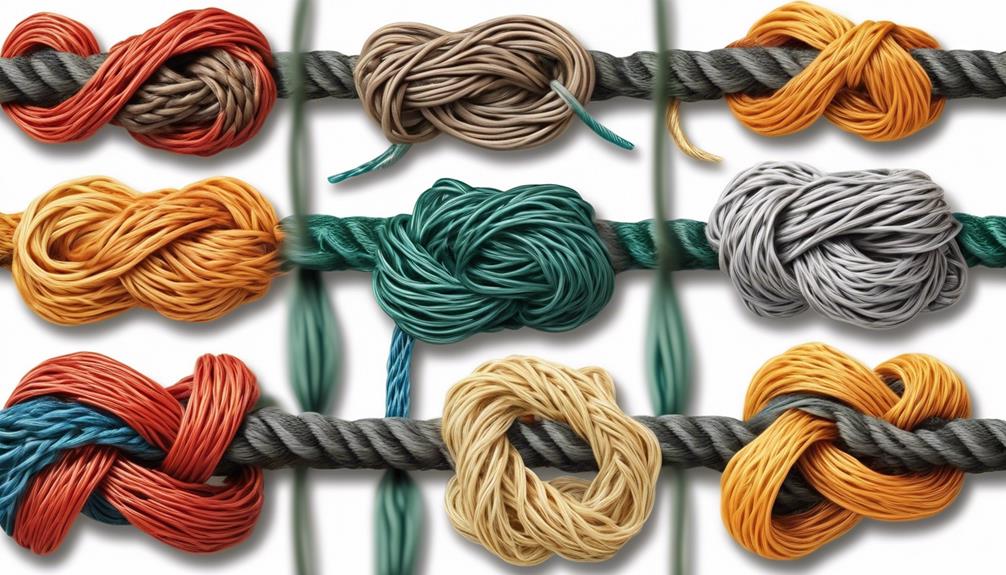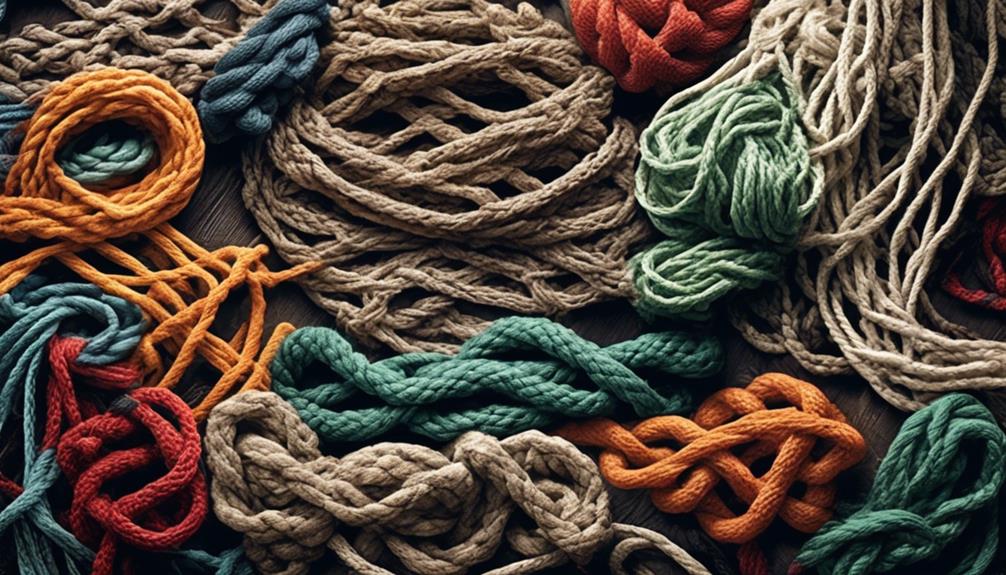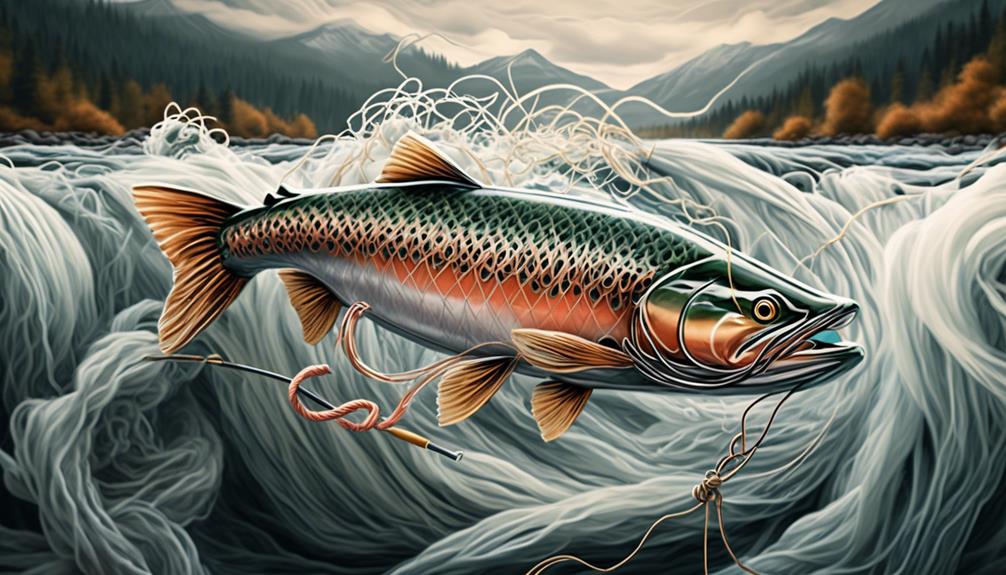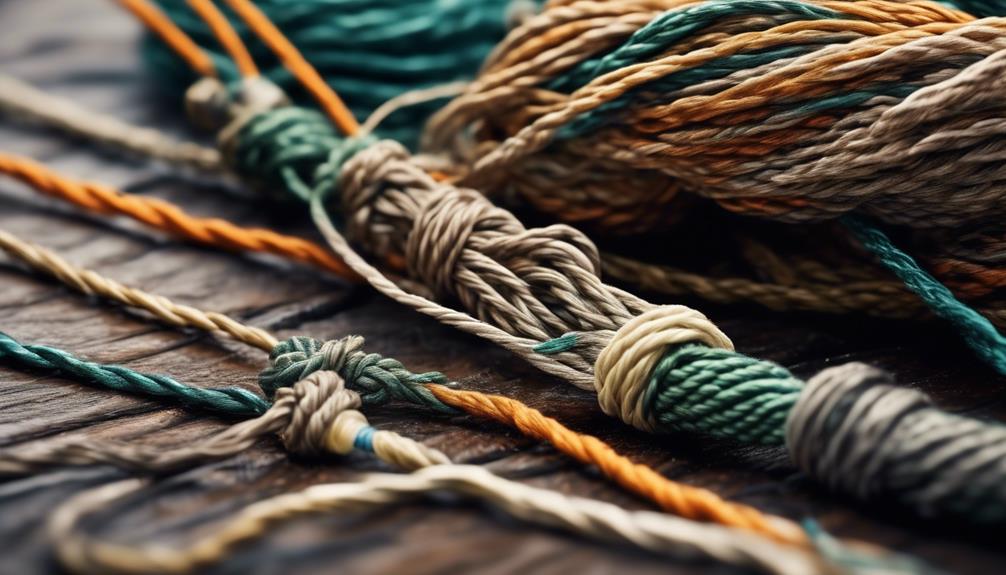You've probably lost more fish due to knot failure than you realize – it's estimated that over 75% of lost fish are due to poorly tied knots.
So, if you want to avoid the frustration of losing another big catch, mastering the art of tying strong and reliable knots is essential.
Whether you're a seasoned angler or just starting out, having a repertoire of dependable knots for monofilament line can make all the difference in your fishing success.
These seven knots are tried and true, and knowing how to tie them will give you the confidence to tackle a variety of fishing situations.
Improved Clinch Knot
Improved Clinch Knot is a reliable and simple knot that's widely used by anglers to secure hooks, lures, and swivels to monofilament fishing line. Its strength lies in its ability to hold well against the pull of fighting fish, making it a popular choice for many fishing scenarios.
To tie the improved clinch knot efficiently, start by threading the end of the line through the eye of the hook and then wrap it around the standing line 5 to 7 times. After that, thread the loose end back through the loop formed near the eye of the hook and then through the big loop just created. Moisten the knot and pull the tag end and the standing line in opposite directions to tighten the knot.
The improved clinch knot strength is derived from the multiple wraps it involves, which provide a firm grip on the hook or lure. This knot is known for its reliability, especially when used with monofilament lines. When tied correctly, it can withstand the force of strong fish without slipping or breaking.
With its simple and efficient tying method, the improved clinch knot is a valuable skill for any angler. Mastering this knot will give you the confidence that your tackle is securely fastened, allowing you to focus on the thrill of the catch.
Palomar Knot
The Improved Clinch Knot is a reliable choice for securing hooks and lures to monofilament line, and now we'll move on to discussing the Palomar Knot.
The Palomar Knot is known for its strength and is particularly well-suited for use with monofilament lines. Here are some advantages and disadvantages of using the Palomar Knot:
- Palomar Knot Advantages
- Offers a high level of strength and reliability, making it suitable for catching larger fish.
- Easy to tie, even in low light conditions, making it a practical choice for night fishing.
- Maintains a high breaking strength, preserving the line's integrity and reducing the risk of breakage during battles with strong fish.
- Palomar Knot Disadvantages
- It may not be as effective with lines that have larger diameters, as it can be challenging to double the line through the hook eye.
- When tied incorrectly, the Palomar Knot can slip, reducing its overall strength and effectiveness.
When tying the Palomar Knot, consider these tips and be mindful of common mistakes to ensure optimal performance:
- Palomar Knot Tying Tips
- Double the line before tying the knot to enhance its strength.
- Moisten the line before cinching the knot to prevent friction and heat generation that can weaken the line.
- Common Mistakes
- Failing to ensure that the double line passes through the hook eye completely.
- Pulling the knot tight too quickly, which can cause the knot to form improperly.
Mastering the Palomar Knot can significantly enhance your fishing experience, providing the confidence needed to tackle larger and more challenging catches.
Uni Knot
Consider using the Uni Knot to secure your hooks and lures to monofilament line, as it offers versatility and reliability for various fishing conditions. The Uni Knot, also known as the Hangman's Knot, is an essential knot that every angler should have in their repertoire. It's incredibly strong and can be used for a wide range of applications, making it a go-to choice for many anglers.
The Uni Knot is renowned for its strength. When tied correctly, it retains a significant amount of the line's original strength, ensuring that your connection between the hook or lure and the monofilament line remains secure, even when battling larger fish. This knot's reliability in maintaining its strength under pressure makes it an excellent choice for various fishing scenarios.
One of the most significant advantages of the Uni Knot is its versatility. It can be used to tie hooks, swivels, and lures to the monofilament line with ease. Additionally, the Uni Knot is suitable for joining lines of different diameters, making it a valuable knot for various fishing techniques. Whether you're casting for bass in freshwater or targeting larger saltwater species, the Uni Knot can handle the task.
Surgeon's Knot
Now that you've mastered the Uni Knot's versatility and reliability, let's move on to discussing the Surgeon's Knot for joining two lines of monofilament.
The Surgeon's Knot is a popular choice due to its simplicity and effectiveness. Here's a step-by-step tutorial to help you understand this tying technique and its common uses:
- Tying Technique
The Surgeon's Knot is formed by overlapping the two lines to be joined and then tying a simple knot with the doubled lines. It's completed by passing the tag end through the loop formed and then pulling it tight. This creates a strong and reliable connection between the two lines.
- Strength Comparison
When comparing the strength of the Surgeon's Knot to other joining knots, it's essential to note that when tied correctly, the Surgeon's Knot retains a high percentage of the line's original strength, making it suitable for various fishing applications.
- Common Uses
The Surgeon's Knot is commonly used for connecting two lines of similar or different diameters, making it an ideal choice for joining leaders to the mainline, attaching tippets, or connecting two fishing lines of different strengths. Its simplicity and strength make it a favorite among anglers.
Mastering the Surgeon's Knot will enhance your angling experience, providing you with a reliable connection that maintains the strength of your monofilament line.
Blood Knot
For a secure connection between two lines of monofilament, consider using the blood knot to join them effectively and reliably. The blood knot is a popular choice among anglers for its exceptional strength and reliability. When compared to other knots, the blood knot excels in maintaining the original line strength. Its symmetrical structure and wrapping technique distribute the pressure evenly along the knot, minimizing the risk of breakage.
To tie a blood knot, start by overlapping the ends of the two lines you want to join. Then, take one end and wrap it around the other line 3-5 times, while also passing it through the center gap between the lines. Next, repeat the same wrapping process with the other end, but in the opposite direction. Once the wraps are complete, carefully thread the tag ends through the center gap in the opposite direction. Moisten the knot and pull both tag ends simultaneously to tighten the knot evenly. Trim the tag ends, leaving a small tag to prevent slippage.
In terms of strength comparison, the blood knot stands out as one of the strongest knots for joining monofilament lines. Its reliability and ability to maintain line strength make it an excellent choice for various fishing scenarios. With the proper tying technique, the blood knot can provide a secure and durable connection, giving you the confidence to tackle even the toughest catches.
Albright Knot
The blood knot's exceptional strength and reliability in joining monofilament lines make it a popular choice among anglers.
Similarly, the Albright Knot offers a versatile and effective method for connecting different types of fishing lines.
When it comes to the Albright knot, its strength and advantages are undeniable. This knot maintains a high percentage of the line's original strength when tied correctly, making it a reliable choice for connecting lines of different materials and diameters. The Albright knot also slides smoothly through rod guides, allowing for better casting and reducing the risk of line breakage during intense fights with powerful fish.
To tie the Albright knot successfully, consider the following tips and common mistakes:
- Tying Tips:
- Moisten the knot before tightening to reduce friction and heat, which can weaken the line.
- Make at least 10 wraps around the main line for better security.
- Practice tying the knot several times at home before using it in a fishing situation.
- Common Mistakes:
- Pulling the knot too tight too quickly, which can cause the wraps to overlap and weaken the knot.
- Not ensuring that the wraps are neatly stacked against each other, leading to a sloppy and unreliable knot.
- Failing to trim the tag end properly, increasing the chances of the knot catching on the rod guides or seaweed.
Double Uni Knot
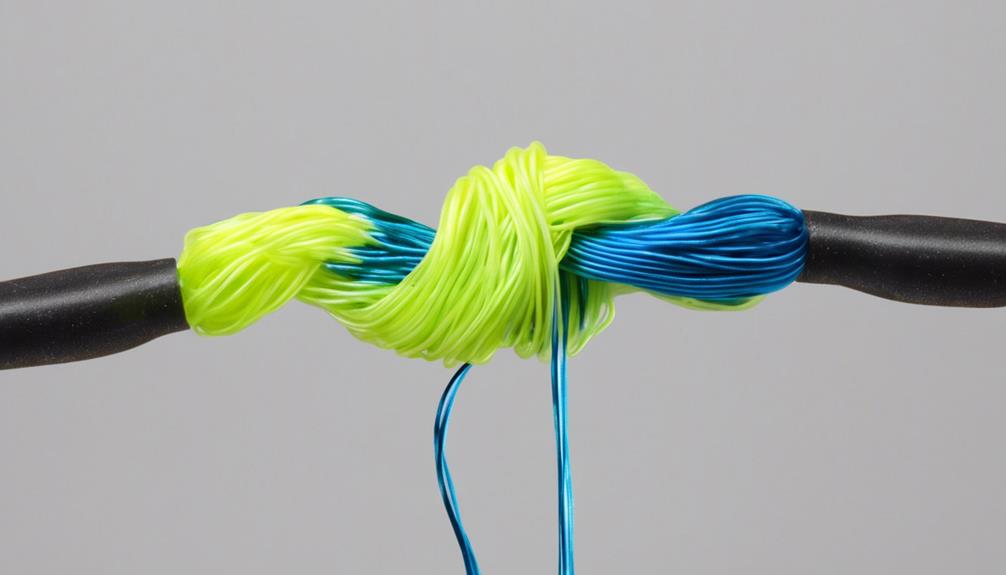
You can create a strong and reliable connection between two lines of similar or different diameters using the versatile and effective Double Uni Knot. This knot is renowned for its ability to maintain line strength, making it a popular choice among anglers. The Double Uni Knot is particularly useful when joining monofilament lines, as it excels in preserving the overall strength of the line connection. Its simplicity and effectiveness have made it a staple in the arsenal of knot tying techniques for anglers of all levels.
When tying the Double Uni Knot, it's important to ensure that the wraps are cinched tightly to prevent slippage. This knot works by creating two opposing overhand knots that are drawn together to form a strong, secure connection. The friction generated by the wraps plays a crucial role in maintaining the strength of the line, making it an ideal choice for monofilament connections.
Additionally, the Double Uni Knot is versatile and can be used with lines of different diameters, further adding to its appeal among anglers.
Frequently Asked Questions
What Are the Best Fishing Knots for Braided Line Instead of Monofilament Line?
When it comes to using braided line instead of monofilament, it's important to consider the advantages and disadvantages.
Braided line offers increased strength and sensitivity, but it can be more visible in clear water.
For heavy lures, the Palomar knot is a top choice due to its strength and ease of tying. The improved clinch knot is also effective for securing heavy lures to braided line.
Are There Any Specific Fishing Scenarios Where the Improved Clinch Knot Is Not the Best Choice?
In certain fishing situations, the improved clinch knot may not be the best choice. For specialized scenarios, such as using larger diameter lines or tying lines to hooks with small eyes, alternative knots like the Palomar or Trilene knot can be more effective.
These alternative knot choices provide better strength and security, making them suitable for specific fishing scenarios where the improved clinch knot may not perform as well.
Can the Palomar Knot Be Used for Other Types of Fishing Tackle, Such as Swivels or Snaps?
Yes, the Palomar knot can be used for other types of fishing tackle like swivels or snaps. This knot has versatile applications and isn't only limited to securing hooks. It's a reliable choice for connecting various fishing accessories due to its strength and simplicity.
Whether you're attaching swivels or snaps, the Palomar knot is an excellent alternative for securing your fishing gear.
Are There Any Variations of the Uni Knot That May Be Better for Certain Fishing Situations?
When it comes to fishing, it's always good to have options. Alternative knots to the uni knot can be advantageous in specific situations. They offer different strengths and weaknesses, so it's important to choose the right one for the job.
Some variations may provide better performance with certain types of tackle or in particular fishing conditions. It's worth experimenting with different knots to find what works best for you.
Is There a Specific Type of Fishing Line That the Surgeon's Knot Is Not Recommended For?
When using fluorocarbon line, the surgeon's knot isn't recommended due to its tendency to slip. This knot is great for joining two lines of similar diameter, but it may not hold well with fluorocarbon. However, it works well for monofilament and braided lines.
In fly fishing, the surgeon's knot is popular for tying tippet to the leader. It's strong and relatively easy to tie, making it a go-to for many fly fishing techniques.
Conclusion
So there you have it – the 7 best fishing knots for monofilament line. Whether you're a beginner or a seasoned angler, these knots will help you secure your line and catch more fish.
Remember to practice tying these knots before hitting the water, and always check your knots for strength and security.
With these essential knots in your arsenal, you'll be ready to tackle any fishing adventure with confidence.
Happy fishing!
